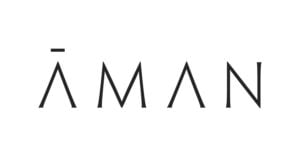
Aman Resorts is a globally renowned luxury hotel group known for its minimalist design, focus on tranquillity, and deep integration with local environments and cultures. The hotel has grown from a single boutique property to an international collection of exclusive resorts. It is definitely a story of vision, innovation, and resilience. The Aman Resorts logo reflects the brand’s core values of peace, simplicity, and timelessness. The article explores the evolution of the Aman Resorts logo, among other details of the brand.
The Genesis of the Aman Resorts Logo (1988 – 2016)
The original Aman Resorts logo displayed the brand name in two levels in a sans-serif typeface in monochrome. The wordmark “Aman” in bold uppercase was displayed in a bigger size, and the letter “A” had a tilde sign on top of it. The wordmark “Resorts”, on the other hand, was in a much smaller size but with pointed serifs.

(2016 – Today)
The latest Aman Resorts logo was designed in 2016 by the London-based design studio Construct. The custom typography features a series of strokes that suggest a physical sense of “above and below”. It echoes the natural connection and flow of mountains, valleys, waves, and the ocean floor. The logo features only the wordmark “Aman” in uppercase and in a custom serif typeface. The letter “A” in the wordmark does not have any horizontal middle bar.

The Elements of the Aman Resorts Logo
Font
The Aman Resorts logo features a custom-designed sans-serif font inspired by ancient scripts and early alphabets. The typography shows simple, elegant strokes with flaring terminals and light line weights. It reflects the brand’s philosophy of peace, serenity, and connection to place.
Colour
The Aman logo is displayed in monochrome black. The restrained colour scheme aligns with Aman’s ethos of tranquillity and timelessness.
The History of Aman Resorts
Aman Resorts was founded in 1988 by Adrian Zecha, who was an Indonesian hotelier with a passion for redefining luxury hospitality. The concept began when Zecha sought to build a holiday home for himself in Phuket, Thailand. This idea soon expanded into creating a small, boutique resort with friends, including Anil Thadani. The resort so created was rooted in intimacy, privacy, and a harmonious relationship with nature.
The first property, Amanpuri (meaning “place of peace”), opened on Pansea Beach in Phuket. It was built with private funds due to the reluctance of the banks to finance such a small-scale project. Amanpuri set a new standard for luxury with its traditional Thai architecture, stunning ocean views, and nightly rates far above local competitors. The resort’s success established the template for future Aman properties characterised by boutique scale, architectural sensitivity, and exceptional service.
After the success of Amanpuri, Aman Resorts expanded rapidly in the early 1990s. By 1992, the group had opened several resorts in Indonesia, Bora Bora, and Courchevel in the French Alps. Each property was designed to blend seamlessly with its environment by using local materials and craftsmanship to reflect the unique character of its location.
Aman’s approach was distinctive as the brand prioritised cultural preservation and authenticity. It ensured every resort offered guests a genuine connection to its setting. This philosophy attracted a loyal following, often referred to as “Amanjunkies”, who appreciated the brand’s blend of luxury, exclusivity, and sense of place.
The company’s ownership structure changed several times as it grew. In 1992, Zecha sold a controlling interest to Clement Vaturi, which was later acquired by Colony Capital in 1998. This led to a period of legal disputes and Zecha’s temporary resignation. However, post-settlement in 2000, Lee Hing Development, a Hong Kong investment company, took control, and Zecha returned as chairman and CEO.
Under Zecha’s renewed leadership, Aman expanded further into Cambodia, India, Bhutan, Sri Lanka, and the Caribbean. In 2007, India’s DLF acquired the controlling stake, which further fuelled the international expansion of the brand.
Aman Resorts continued to innovate by introducing concepts such as Aman Wellness in 2005, which integrated holistic well-being into the guest experience. In 2013, Aman Tokyo marked the brand’s entry into urban hospitality, wherein it brought its signature tranquillity to a metropolitan setting. The brand also launched unique travel experiences such as Aman Private Jet Expeditions and Aman Adventures. These offered immersive journeys for its discerning clientele.
Today, Aman operates over 30 resorts, hotels, and private residences across more than 20 countries. Each property maintains the brand’s commitment to authenticity, sustainability, and exceptional service. Aman’s reputation for excellence has earned it numerous awards and a devoted global following. Aman Resorts stands as a pioneer in luxury hospitality. It continues to set new standards for elegance, experience, and environmental harmony.
Interesting Facts About Aman Resorts
- The first Aman Resort, Amanpuri, opened in Phuket, Thailand, in 1988. It was designed to feel like a private home, with just a handful of rooms.
- The name “Aman” means “peace” in Sanskrit, which reflects the brand’s core ethos of tranquillity and serenity in every guest experience.
- Aman currently operates 36 hotels, resorts, and residence developments across 20 countries. And fifteen of these are located close to or within UNESCO-protected sites. These showcase the brand’s commitment to cultural and environmental preservation.
- Each Aman property is designed to blend seamlessly with its natural surroundings. The brand uses local materials and traditional craftsmanship to ensure each resort reflects the unique character of its destination.
- Aman has cultivated a devoted community of repeat guests known as “Amanjunkies”. These travellers are drawn to the brand’s unique blend of luxury, authenticity, and exclusivity.
- Aman introduced the Aman Wellness concept in 2005. This concept integrated holistic well-being, traditional healing, and spa treatments into the guest experience. In recent years, the brand has expanded into skincare, supplements, and fine fragrances.
- Aman Resorts has received numerous accolades, which include being named the first-ever winner of the “Most Admired Hotel Group Award” at the World’s 50 Best Hotels awards. Individual properties like Aman Tokyo and Aman New York are consistently ranked among the world’s best hotels.
- Beyond traditional stays, Aman offers Aman Private Jet Expeditions and Aman Adventures. These provide guests with immersive and exclusive travel experiences in some of the world’s most breathtaking locations.
- Many Aman staff members have been with the company since its inception. They help foster deep connections with local communities and ensure a consistent, high-quality guest experience.
- Aman continues to expand, with ten new projects announced as part of a robust future pipeline. The brand’s growth includes both resort and urban properties, such as Aman New York.
- Aman Venice is housed in the Palazzo Papadopoli, which is a 16th-century palazzo on the Grand Canal in Venice, Italy. It offers guests the rare experience of staying in a living piece of history.
Finally
The Aman Resorts logo has evolved from an almost invisible mark to a sophisticated, meaningful emblem. The logo encapsulates the brand’s philosophy and connection to place. Its evolution shows Aman’s growth, that is, from a single discreet resort in Phuket to a global collection of havens.